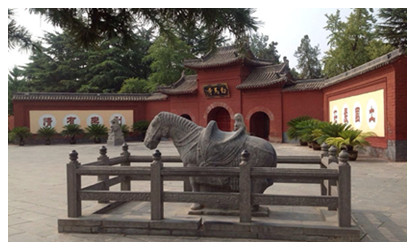- Home
- Travel In China > China Culture > Chinese Architecture >
Chinese Buddhist Temple History
After
Buddhism spread into China in the Eastern Han Dynasty (25- 220), Chinese Buddhist Temple was also introduced into the country as a kind of Indian Buddhist buildings. Architects at that time combined the this one with traditional Chinese architecture style and created Chinese style temple buildings.
 From 3rd century to 4th century
From 3rd century to 4th century This was the earlier period of Buddhism in China. Temple buildings were called "Ci" and the temple layout followed its Indian counterpart with a pagoda as its central focus surrounded with halls and towers. The first Buddhist temple in China was the White Horse Temple, located in what is now, Luoyang, Henan Province.
From Mid- 4th century to Mid- 10th century
This period spans China's Northern and Southern Dynasties, Sui and Tang and Five Dynasties and Ten States. (See our China History , if you are confused by these periods.) Favored by feudalist rulers, Buddhism gradually reached the height of its development from an exotic to a prevailing countrywide religion in this period. Buddhist architecture saw a great development in both numbers and size of their temples and by the end of the Northern Wei Dynasty, there were over 1400 temple in its capital city Luoyang and over 40,000 throughout the country. Temple architects began to use sophisticated courtyard complex in their temples and the layout of different buildings employed a systematic arrangement similar to the symmetrical palace structure rather than the early pagoda-centered form. Buddhist pagodas, as their roles faded away were moved to the rear part of the temple. It was in this period that the Chinese temple art took its own shape and achieved its great success.
Murals from Mogao Grottoes (a noted Buddhist cave in what is now Dunhuang City) illustrated the development of the temples in the Tang Dynasty. Temples at that time had more courtyards, halls, towers, pavilions and intricate designs and decorations are applied to eaves, roofs, balustrades, gateways and interior ceilings. The temple architecture technique reached a high level.
From Mid- 10th century to 20th century
In this period, Buddhism experienced several ups and downs before it declined in recent centuries. The Buddhist temples saw no more changes on the architecture structure. Architects concentrated on gorgeous and solemn style and the notable scale of the complex. Zhihua Temple and Guangji Temple in
Beijing and Chongshan Temple in Taiyuan are fine examples of this type. Meanwhile another kind of Buddhist temples were introduced landscape scenery and different buildings such as gateways, pavilions, towers, temple halls in simple style were scattered over mountains and the temples seemingly borrowed from the surrounding hills and waters into its complex to create a harmonious integration between temple buildings and the environment. This embodies the traditional Chinese philosophy of keeping harmony with nature. Four Buddhist Holy Mountains (including Mt. Jiuhua; Mt. Emei; Mt. Putuo; and Mt. Wutai) are of this kind.
Temple buildings were called "Ci"
After Buddhism was introduced into China, temples were called Ci or Lanruo, Jialan, Jingshe and other names. Till the Ming Dynasty (1368- 1644), the word "Si", was used to refer to temples throughout the country. The word was originally used for palaces or mansions of high officials in China's early Qin Dynasty (221BC - 206 BC) and it referred to high administrative institutions in the Han Dynasty. People used it for Buddhist temples to show their respect to this religion.

 From 3rd century to 4th century
From 3rd century to 4th century  Ask Questions ?
Ask Questions ?